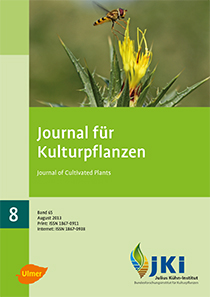Investigation of the distribution of <em>Strauzia longipennis </em> Wied. in Berlin and in the Federal Land Brandenburg
DOI:
https://doi.org/10.5073/JfK.2013.08.01Keywords:
Fruit fly, Strauzia longipennis, sunflower maggot, Helianthus, mining, sunflower, quarantine pestAbstract
The sunflower maggot Strauzia longipennis Wied. is endemic in North America. First observations on the fruit fly in Europe were obtained in Berlin and dates back to 2009/10. Considering the adaption of the species to climatic conditions in Central Europe and the status as quarantine pest an extensive survey on the occurrence of the fruit fly was carried out in Berlin and Federal Land Brandenburg in 2011. The infestation with S. longipennis was investigated on sunflower H. annuus as well as Jerusalem artichoke H. tuberosus L. Therefore, plants were examined growing on fields i.e. sunflower fields and other crops (plants growing through or growing on the edges) as well as plants from a nursery, from experimental fields, backyards, allotments and roadsides. Further monitoring was conducted in 2012 in Land Brandenburg to achieve an overview of the situation of infestation, whereas in Berlin, two sides were closely examined. In 2011 S. longipennis was found in Land Brandenburg and Berlin. In Brandenburg, on 27 locations mostly cultivated with Helianthus annuus L. were plants registered to be infested with the fruit fly. Only in districts Oberspreewald-Lausitz and Prigniz, the sunflower maggot could not be detected. In Berlin infested plants were observed at 16 locations. One year later, the number of positively tested fields in Brandenburg declined. The sunflower maggot could be detected only on two fields. Furthermore, abundance on these fields was low. Nevertheless, relatively high abundance of the species was observed at two locations in Berlin. The results of both years verify the territorial wide distribution of the sunflower maggot within Berlin and the Federal Land Brandenburg. Further, significant variations of abundance between the years were shown. Despite the differences in the years, the repeated presence of S. longipennis in Berlin and Land Brandenburg proves the permanent establishment of the species within the region. Additionally, it can be assumed that the introduction of the species in Germany must have taken place quite earlier than with the first detection in Berlin in 2009/10. Furthermore, the study demonstrates the Jerusalem artichoke H. tuberosus as another host plant of the fly species within Germany. The occurence of S. longipennis in Berlin and Land Brandenburg for several years and the lack of knowledge regarding the introduced population emphasize the need for further research.
Downloads
Published
Issue
Section
License
The content of the journal is licensed under the Creative Commons Attribution 4.0 License. Any user is free to share and adapt (remix, transform, build upon) the content as long as the original publication is attributed (authors, title, year, journal, issue, pages).
The copyright of the published work remains with the authors. The authors grant the Journal of Cultivated Plants, the Julius Kühn-Institut and the OpenAgrar repository the non-exclusive right to distribute and exploit the work.







